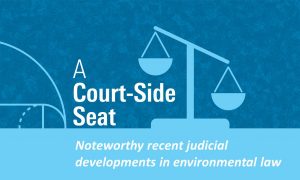Clean Air, Clean Water, Citizen Suits and the Summer of 2022 — Gravel2Gavel Construction & Real Estate Law Blog — September 27, 2022
This is a selection of significant environmental and regulatory law cases decided by the federal courts after the Supreme Court’s 2021 Term concluded.
The U.S. Court of Appeals for the DC Circuit
National Association of Broadcasters v. Federal Communications Commission
On July 12, 2022, the DC Circuit held that an order of the FCC requiring radio broadcasters to follow a prescribed five-step process to verify the identity of program sponsors was not authorized by the Communications Act. According to the court, the FCC “decreed a duty that the statute does not require, and that the statute does not empower the FCC to impose.” Here, the agency failed to identify the statutory authority it needed to authorize the issuance of such an order. While certainly not as significant as the Supreme Court’s ruling in West Virginia v. EPA, decided only a few days before this decision was released, it is a strong reminder that the courts want to know if a challenged rule is authorized by law.
Humane Society of the U.S., et al., v. U.S. Department of Agriculture
On July 22, 2022, the court decided a case involving the steps the Administrative Procedure Act and the Federal Register Act require to be taken before a final agency rule is legally promulgated. Customarily, when there has been a change in Presidential administrations, the incoming administration “quietly” withdraws rules awaiting Federal Register publication without much ceremony. The majority of this panel agreed that public notice should have been provided to the regulated community to comment on the new administration’s action to pull back a new rule which had been made available for public inspection before Federal Register publication that would have strengthened the protections afforded “show horses,” as now required by law. The court noted that “it seems clear that filing with the Federal Register constituted promulgation of a regulation even though publication may not occur until a later date.” Circuit Judge Rao filed a strong dissent. “By cutting off agency discretion at public inspection, the majority imposes judicial burden on agency procedures that conflicts with circuit precedent, the statutory framework and a longstanding regulation permitting withdrawals prior to publication.” There could be a further review of this unique ruling.
Sierra Club, et al., v. EPA
In administering the 2008 Ozone NAAQS, EPA “lifted” ozone anti-back sliding requirements for the Dallas and Houston Clean Air Act nonattainment areas. The Sierra Club filed lawsuits challenging this action in the DC Circuit and Fifth Circuit Court of Appeals. On August 26, 2022, the court held that it did not have jurisdiction over this EPA action because it was not an action that was “nationally applicable,” and the court also had no jurisdiction to second guess the EPA’s discretionary action to make and publish—or not—a finding of nationwide scope and effect. The DC Circuit then transferred the matter to the Fifth Circuit. This case may have considerable impact in the future when a Clean Air Act regulation may arguably have only a limited local, not national, effect.
Solenex LLC v. Bernhardt, et al.
On September 9, 2022, the court issued another ruling in the long-running controversy over the administrative cancellation of Montana oil and gas leases that had been granted by the Department of the Interior in 1982. Judge Leon described the matter as consisting of a never-ending series of administrative reviews, a process which he called “Kafkaesque.” In his view, the original NEPA reviews were consistent with the law, and the intermittent statutory challenges did not reflect the law at the time the leases were granted. A few years ago, the DC Circuit reversed an earlier ruling by Judge Leon that the interminable delays were reason enough under the Administrative Procedure Act to warrant relief. Here, Judge Leon concluded by holding the Secretary’s most recent cancellation of the Lease as being without statutory authority, arbitrary and capricious: “It is time to put an end to this interminable and insufferable bureaucratic chess match.”
U.S. Court of Appeals for the Third Circuit
Shark River Cleanup Coalition v. Township of Wall, et al.
On August 24, 2022, the Third Circuit decided this case, in which the defendants argued that the Citizens Suit notice was deficient under the law because it failed to contain sufficient information to permit the defendants to identify the specific standard, limitation or order alleged to have been violated, citing 40 CFR Section 135(a). The township had taken by eminent domain a subterranean easement on the property that was to be used as the site of an underground sewer line system. Years later, a hiker discovered that portions of the underground sewer line no longer remained underground. The complaint averred that erosion of the ground surrounding the buried sewer line released large amounts of sand into the Shark River Brook. While the notice passed muster as to the site’s location in the woods, the court held that the notice was deficient because it did not provide enough notice to the government defendants to identify the specific effluent discharge limitation that had been violated. This defect caused the court to affirm the lower court’s dismissal of the lawsuit.
Yaw, et al. v. The Delaware River Basin Commission
On September 18, 2022, the Third Circuit affirmed the lower court’s dismissal of a challenge by many Pennsylvania legislators and representatives of several Pennsylvania townships to a decision of the Delaware River Basin Commission to ban fracking operations within the Delaware River Basin. The Commission determined that fracking poses “long-term risks to the development, conservation, utilization, management and preservation of the Basin’s water resources.” The plaintiffs argued that this action exceeded the Commission’s authority, violated the Takings Clause of the Constitution, illegally exercised the power of eminent domain, and violated the Constitution’s guarantee of a republican form of government. However, the court of appeals, like the lower court, dismissed the lawsuit on standing grounds. While the Commission’s decision may not be good policy, the plaintiffs lack standing because their alleged institutional injuries do not satisfy the traditional tests of Article III standing.
U.S. Court of Appeals for the Fourth Circuit
Natural Land Trust v. Dakota Finance LLC
On July 29, 2022, the Fourth Circuit held that the diligent prosecution exception was not triggered by a Notice of Violation issued by the South Carolina Department of Health and Environmental Control in September 2019. Sixty days after the statutory notice expired, the conservation defendants filed a CWA Citizens Suit against Arabella Farms, which was developing its property to operate a working farm and wedding venue. A month after the lawsuit was filed, the department and Arabella Farms entered into a consent decree that required the acquisition of requite permits and the payment of a $6,000 fine.
U.S. Court of Appeals for the Fifth Circuit
TransUnion LLC v. Ramirez
On August 30, 2022, a divided panel of the Fifth Circuit sustained the decision of the lower court that the ExxonMobil refinery complex in Baytown, Texas, had violated the Clean Air Act in the operation of its facilities and is subject to $14.5 million in penalties. This is the third decision the Fifth Circuit has issued in this hard-fought proceeding. In this latest round, ExxonMobil argued that the Supreme Court’s recent decision in TransUnion LLC v. Ramirez, 141 S. Ct. 2190 (2021), substantially changed the standing jurisprudence of the federal courts. The panel majority disagreed, holding that the TransUnion case did not affect Circuit precedent. Judge Oldham, in dissent, remarked that “This case is a jurisdictional mess, that only a Fifth Circuit en banc court can correct.”
Net Choice, LLC, et al. v. Ken Paxton, Attorney General of Texas
On September 16, 2022, in an opinion by Judge Oldham, the Fifth Circuit held that a recent Texas statute, HB 20, which “generally prohibits large social platforms from censoring speech based on the viewpoint of the speaker was constitutional.” The opinion is very long, well over 100 pages in which all members of the panel expressed their views of the law. Judge Oldham observed that the constitutional challenge was filed before the State of Texas began to enforce the law. The court held that the statute does not “chill speech,” but, if anything, it chills censorship. Also, the First Amendment offers no support for the plaintiffs’ claimed right to censor. Judge Southwick in dissent argued that social media platforms engage in First Amendment-protected expression when they moderate their users’ content.
U.S. Court of Appeals for the Ninth Circuit
California State Water Resources Control Board v. Federal Energy Regulatory Commission
On August 4, 2022, the court decided this Clean Water Section 401 case. Section 401 requires states to provide a water quality certification to applicants for federal permits before a federal permit can be issued for activities that may result in any discharge into intrastate navigable waters. The law also provides that the states must exercise that authority within one year of receiving the application, or their certification authority will be waived. Here FERC, in the aftermath of Section 401 certification rulings by the DC Circuit, determined that the state Water Board was engaged in coordinated schemes with other local governments whereby repeated filings to withdraw and resubmit the application would nullify the impact of the statutory deadline. However, the court held that FERC’s findings of coordination between the state board and the applicants were not supported by substantial evidence. Here, the court held that record evidence shows that applicants themselves chose to withdraw and resubmit Section 401 applications because it was clear to them that they could not timely comply with the California CEQA rules, and the errant FERC orders were vacated.
RELATED ARTICLES
A Court-Side Seat: Case Law Update (February 2022)






